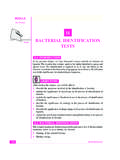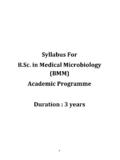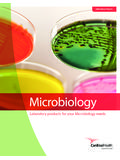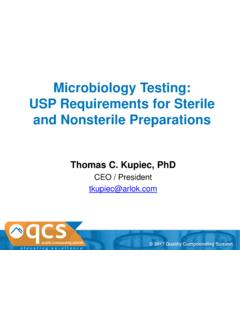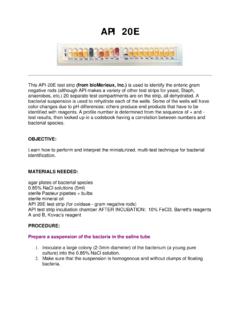Transcription of Identification of Bacterial Species
1 Association for Biology Laboratory Education (ABLE) ~ 103 Chapter 8 Identification of Bacterial Species Kimberley Christopher and Elsa Bruno Department of Biological Sciences University of Alberta Edmonton, Alberta, CANADA T6G 2E9 Kimberley Christopher, , is a laboratory coordinator at the University of Alberta for an introductory cell biology course with 800-1200 students per term. Elsa Bruno is a bacteriology technologist at the University of Alberta for an introductory cell biology course with 800-1200 students per term. 2003 University of Alberta Reprinted From: Christopher, K. and E. Bruno. 2003. Identification of Bacterial Species .
2 Pages 103-130, in Tested studies for laboratory teaching, Volume 24 (M. A. O Donnell, Editor). Proceedings of the 24th Workshop/Conference of the Association for Biology Laboratory Education (ABLE), 334 pages. - Copyright policy: Although the laboratory exercises in ABLE proceedings volumes have been tested and due consideration has been given to safety, individuals performing these exercises must assume all responsibility for risk. The Association for Biology Laboratory Education (ABLE) disclaims any liability with regards to safety in connection with the use of the exercises in its proceedings volumes. 104 Bacterial Identification Contents Materials.
3 104 Student Outline ..106 First Week of Lab ..106 Second Week of Lab ..109 Notes for the Instructor ..119 Appendix A: Recipes ..122 Appendix B: Results ..123 Introduction The laboratory exercise is designed to introduce first-year cell biology students to several standard microbiological tests that can be used in an initial Identification of an unknown Bacterial Species . In the first week, students are provided with a mixed Bacterial culture containing three Species , whose identity is unknown to the students. Students use the streaking technique to isolate individual colonies of the three Species . Including the prelab talk and postlab discussion, this portion of the lab takes approximately 45 minutes for students to complete.
4 Preparation and set up for this portion will take up to 3 hours for a lab of 20 students. In the following week, students examine the colonies of the three unknown bacteria to determine colony morphology. Additionally, students perform Gram staining on cells of the isolated colonies to determine the Gram reaction, cell morphology, and cell size of the unknown bacteria. Students are also supplied with the test results of four morphological/biochemical/nutritional tests to learn more about the three unknown Species . A comparison is then made with the same test results of six Bacterial Species , whose identities are known, in an attempt at an initial Identification of the three unknown bacteria in the mixed Bacterial culture.
5 The morphological/biochemical/nutritional tests that are included in this lab were chosen based on their relevance to the theoretical material taught in the lecture component of the course. Including the prelab talk and postlab discussion, this portion takes 3 hours for students to complete. Preparation and set up for this portion will take up to 3 hours for a lab of 20 students. Materials Equipment (numbers are based on a lab session of 20 students, arranged into 8 groups on 4 lab benches) First week of lab: (24) PCA agar plates (16) inoculating loops (8) Bunsen burners (4) strikers (4) wash bottles of Roccal (any disinfectant will work) (4) test tubes containing ml of a mixed Bacterial culture (Stock culture is: 5 ml E.)
6 Coli, 75 ml Staphylococcus epidermidis, and 75 ml Bacillus subtilis, all grown in TCS broth) (2) autoclave bags (doubled bagged) (1) test tube containing uninoculated broth for demonstration of turbidity Bacterial Identification 105 Second week of lab: (6) dissecting microscopes (1 per known Bacterial Species set-up) (8) compound microscopes with 100X oil immersion objective lenses and ocular micrometers (1 per group of students) (1) box of lens paper (4) Bunsen burners and strikers (4) bottles of immersion oil (4) boxes of glass slides (4) Gram stain stations (1 station per bench), which includes.
7 (1) Coplin jar of crystal violet (1) Coplin jar of Gram s iodine (1) wash bottle of 95% ethanol (1) Coplin jar of Safranin (2) grease pencils (2) pairs of forceps (2) inoculating loops (2) 600 ml beakers (20) mixed culture agar plates (made by students; see First week of lab, above) (1) pure culture agar plate of (PCA) Micrococcus luteus (ATCC 4698), labeled as such (1) pure culture agar plate of (TCS) Lactobacillus plantarum (ATCC 8014), labeled as such (2) pure culture agar plates (PCA) of Bacillus subtilis var. niger, one labeled as such, one labeled as 1 (2) pure culture agar plates (PCA) of Staphylococcus epidermidis (ATCC 155), one labeled as such, one labeled as 3 (3) pure culture agar plates (PCA) of Escherichia coli (NCIB 8666), one labeled as such, one labeled as 2 , one labeled as Proteus vulgaris (1) set of Test Results for the Unknown bacteria (1) set of Test Results for the Known bacteria (1 information sheet for each Known station) (2) sets of How to Read the Test Results information sheets (6)
8 Sets of Descriptive terms of colony morphology (1 for each Known station) (1) set of Gram stained photomicrographs (1 photomicrograph for each Known station) (2) autoclave bags (double bagged) Chemicals First week of Lab: PCA (Plate Count Agar): either purchase pre-mixed powder and add water or use chemicals below o pancreatic digest of casein o yeast extract o glucose o agar TCS (Trypticase Soy broth): either purchase pre-mixed powder and add water or use chemicals below o pancreatic digest of casein o soybean peptone o NaCl o K2 HPO4 o glucose Second week of Lab: PCA (Plate Count Agar) TCS (Trypticase Soya Agar) o pancreatic digest of casein o soybean peptone o NaCl o K2 HPO4 o glucose o agar Crystal violet Ammonium oxalate 98% ethanol 95% ethanol Iodine Potassium iodide Safranin 106 Bacterial Identification Student Outline First Week of Lab Objectives: 1.
9 To learn the characteristics of aseptic technique 2. To learn how to streak cells from a liquid Bacterial culture onto an agar plate. Cultures of Bacterial cells are kept in the lab environment in many different forms. One common form is a liquid culture -- a suspension of millions of cells in a liquid medium that contains all the nutrients required for cell growth. In this lab, you will be given a liquid culture containing a mixture of three different Bacterial Species . You will attempt to identify the three Bacterial Species in this first week using several standard microbiology Identification techniques. However, before you can attempt to identify the individual Bacterial Species , you will need to separate the bacteria in the mixed liquid culture from each other.
10 The method you will use to accomplish this is a technique called streaking. The objective of this technique is to deposit single Bacterial cells from the liquid culture over the surface of the agar medium in the plate. The streaking technique allows you to do this as each successive streak dilutes the number of cells from the previous streak, ideally resulting in single cells deposited within the area of the final streak (see Figure 2). Once the cells have been streaked onto an agar plate, the plate will be placed in an incubator (at an optimal temperature) to allow the cells to grow and divide. A single cell will divide numerous times to form a small mass of cells on the plate where the original single cell was deposited.
